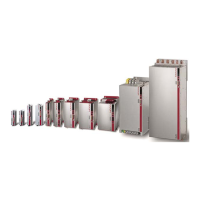this case, a check should first be made as to whether the preset maximum value
P340[0] - CON_FM_Imag has already been reached and can be increased. If the
maximum value has not yet been reached, the voltage controller is not dynamic
enough and the gain P345[0] - CON_FM_VConKp must be increased.
If no suitable compromise can be found, the voltage threshold as from which the
voltage control intervenes must be reduced by the scaling parameter P347[0] -
CON_FM_VRef. If the response with voltage controller is unproblematic and no
particular demands are made in terms of dynamism, the available torque can be
optimized by setting P347[0] - CON_FM_VRef to values up to 98 %.
MOOG
ID
No.: CB40859-001 Date: 02/2018
MSD Servo Drive- Device Help
144
7 Control
7.8Synchronousmotorautocommutation
For field-oriented regulation of permanently excited synchronous motors with a
purely incremental measuring system, the commutation position must be determined
once when the control is started (adjustment of current rotor position to encoder zero
[encoder offset]). This procedure is executed by the "Auto commutation" function
after initial enabling of the control when the mains voltage has been switched on for
the first time. It can also be forced during commissioning by changing a parameter,
which causes a complete controller initialization (e.g. change of auto commutation
parameters, change of control mode etc.). Owing to the differing requirements
arising from the applications, various commutation methods are provided (P390[0] -
CON_ICOM).
To check in commissioning whether the auto commutation has been successful,
P394 - CON_ICOM_Check is provided. It comprises the current commutation angle
error P394[1] - ActVal and a parameterizable limit value P394[0] - Limit. If the
commutation angle error exceeds the specified limit value, an error is generated.

